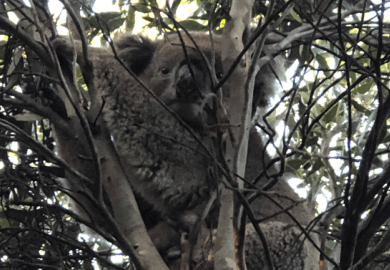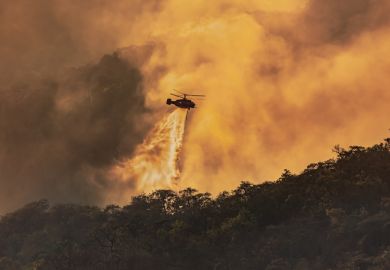This book of photographs by Subhankar Banerjee - the first to document its subject - with essays by leading US environmentalists such as Peter Matthiessen, endorsements from Jane Goodall and E. O. Wilson and a foreword by former President Jimmy Carter, has stirred controversy in the US.
In March, a Democratic senator from California stood on the floor of the Senate in Washington in front of an enlargement of a photograph of a polar bear taken from the book and cited it as evidence of why the Senate should reject yet another bill to allow drilling for oil in Alaska's Arctic National Wildlife Refuge. In the subsequent vote, the Bush administration, which supports drilling, was narrowly defeated - despite the attention focused on US oil imports by the Iraq war.
In April, an exhibition of Banerjee's photographs long scheduled for the main exhibition area of the Smithsonian Natural History Museum was downgraded to the "basement"; its captions were scrubbed of any hint of political advocacy; and the Smithsonian wrote to the publishers requesting that any references to the museum's support for the exhibition (which was set to tour the US) be deleted from future printings of the book.
Were the Senate defeat and the exhibition's downgrading connected? The Smithsonian (which does not announce the exhibition on its website) strongly denied any outside pressure, as did the Republican senator for Alaska sponsoring the legislation. But opponents of drilling are convinced that these photographs were recognised by the supporters of Big Oil as dangerously beautiful and powerful. Potentially, they are as influential as the massive Exxon Valdez oil spill in Alaska that saved the refuge from the drillers in 1989. They should make even the most gung-ho believer in the American public's absolute right to cheap gasoline feel uncomfortable. As for Carter, a supporter of the refuge since his presidential term in the 1970s, "at best, the Arctic refuge might provide 1 to 2 per cent of the oil our country consumes each day. We can easily conserve more than that amount by driving more fuel-efficient vehicles. Instead of tearing open the heart of our greatest refuge, we should use our resources more wisely."
One of the expert contributors, William Meadows, current president of the Wilderness Society, reminds us that Theodore Roosevelt's decision to name the Grand Canyon a national monument in 1908 was opposed by those who thought it "an ugly place, suitable chiefly for copper mining", while only a few people opposed a plan to drain the Everglades - "after all, what good could there be in a swamp"?
The Arctic refuge - 19.5 million acres on the shores of the Beaufort Sea - is less easy to sell. For a start, it is in Alaska and not many Americans have visited it. Second, it is blanketed in snow for some nine months of the year. Third, it does not have the stunning natural features of, say, the Grand Canyon, Yosemite or Yellowstone. Why should we care?
The contributors make a watertight scientific case for the refuge as a unique and exceptionally pristine ecosystem, including a small indigenous population of Inupiat Eskimos and Gwich'in Athabascan Indians. But I imagine that the majority of readers will be seduced by images of the animals in "America's Serengeti", which range from polar bears with irresistible cubs, grizzlies, moose, caribou, musk oxen and wolves to small birds such as the Arctic tern, which breeds in the refuge before setting out on its breathtaking 24,000-mile annual round trip to Antarctica, and the American dipper, which succeeds in feeding even in the depths of winter at - 50F by locating warm waters fed by deep underground sources. Not to mention the "unforgettable Alaskan light" of the midnight sun and the aurora borealis, mentioned by the patient and intrepid Banerjee.
Although the text just occasionally veers into the kind of politically correct language that would no doubt make a neo-conservative Bu****e sneer, Seasons of Life and Land will surely become a classic of American environmental consciousness. It is impeccably researched, intelligently conceived, astonishingly observant and radiant with love for its subject.
Encouraging to report, as a result of the public debate over the Smithsonian exhibition, the California Academy of Sciences has stepped in to support a new exhibition with full captions in San Francisco in September. And a coalition of conservation groups is raising funds to enable the photographs to be seen at the American Museum of Natural History in New York City in October. The Smithsonian Museum authorities should feel ashamed.
Andrew Robinson, literary editor of The THES, is the author of Earthshock.
Arctic National Wildlife Refuge: Seasons of Life and Land
Author - Subhankar Banerjee
ISBN - 0 89886 909 9 and 438 0
Publisher - The Mountaineers Books www.mountaineersbooks.org
Price - $35.00 and $22.95
Pages - 176
Register to continue
Why register?
- Registration is free and only takes a moment
- Once registered, you can read 3 articles a month
- Sign up for our newsletter
Subscribe
Or subscribe for unlimited access to:
- Unlimited access to news, views, insights & reviews
- Digital editions
- Digital access to THE’s university and college rankings analysis
Already registered or a current subscriber? Login



